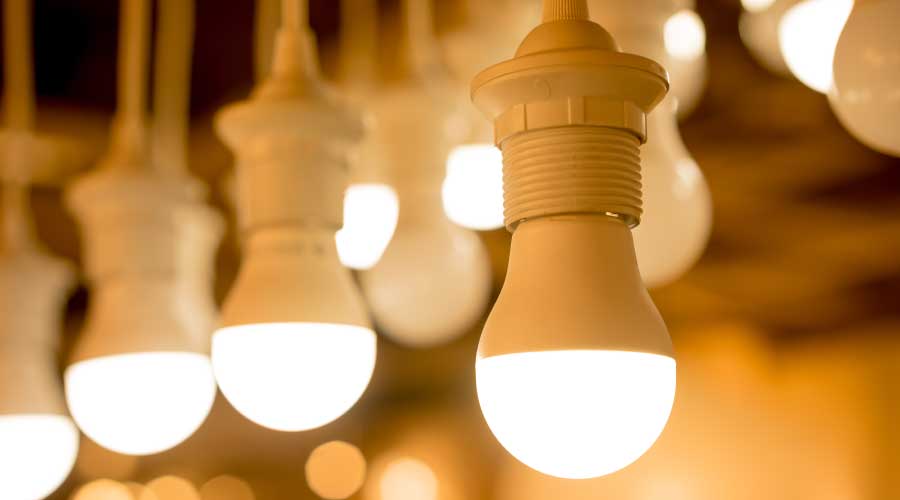Low-Cost Lighting For the Long Term
When systems are being designed, facility executives should evaluate three factors that shape operating costs.
No one deliberately chooses a lamp or fixture that will cost more to operate than one that would do so equally well at a lower life-cycle cost. Yet many buildings have lighting systems that were selected without much regard to operating costs. Unless facility executives and system designers pay attention to factors that influence lighting operating costs, they may be strapping themselves with ongoing costs that could well have been avoided.
Three major cost components should be evaluated when determining operating costs for building lighting systems: energy use, lamps and maintenance. By considering these cost components, facility executives can select the most suitable system for the application with the lowest overall cost of ownership.
Energy Costs
The most commonly considered operating cost is energy. Everyone would agree that the goal is to use the most efficient light source suitable for the application. But the comparison is usually limited to selecting the light source type: incandescent vs. fluorescent, or high intensity discharge (HID) vs. fluorescent. Once the light source is selected, aesthetics and first costs become the determining factors.
That approach fails to consider real energy costs. Different fixtures and lamps, even of the same type, use different amounts of energy to produce the same amount of light. Real energy costs should be evaluated, not just the efficiency of the light source. Given the number of hours that the lighting system operates, even relatively minor differences in energy use will produce significant differences in energy costs.
Three aspects of energy consumption should be considered: energy use, energy demand and the impact the lighting system has on cooling costs.
Energy-use charges, expressed in cents per kilowatt-hour, are for the actual energy used by the lighting system. Reduce the hours that the system is used or reduce the power use of the lighting system, and the energy-use charges will be lowered. But determining the energy operating cost is not as straightforward as it might seem.
Most medium-sized and practically all large facilities are on a time-of-day electric rate structure. To estimate energy costs accurately, facility executives must match projected hours of use to time-of-day rate periods. Simply using an average rate will result in either under- or over-estimating the cost of energy use.
Energy demand is expressed in kilovolt-amperes (kva)and represents the lighting system’s contribution to the overall electrical demand for the facility. Lighting systems are a fairly large component of the facility’s total electrical energy use, so their contribution to electrical demand charges should not be overlooked.
When estimating lighting’s impact on facility electrical demand, consider the total connected load of the lighting system, when it will be in use, how it will affect total electrical demand, and what the demand rate is for the facility. Every kva of lighting that is in use when the facility’s peak demand occurs will contribute to that peak demand.
The impact of the lighting system on HVAC system costs is often overlooked. Every watt of energy used by the lighting system ends up as heat within the facility. During the cooling season, the building’s HVAC system uses additional energy to remove this heat. Again, failing to account for the lighting system’s heat load will underestimate the total energy cost of the system.
It is critical to consider all three energy components when evaluating lighting technologies designed to save energy. Otherwise, facility executives may dramatically over- or under-estimate the savings that could be produced by that technology.
Lamp Replacement Costs
There are two aspects of lamp replacement costs to consider: the cost of the lamp and the cost of the labor required to replace the lamp. Both vary widely with the style of lamp and the design of the fixture.
Consider fluorescent lamps. Lamps are available in a variety of sizes, from compact lamps to 8-foot tubes. The most commonly used tube diameters are the T12, T8 and T5. Most tubes are either straight or U-bent.
Prices vary widely with tube design, with the most economical tubes being the standard 4-foot tube. T5 lamps are more expensive than T8 or T12, but they are more efficient.
The U-tube makes it possible to fit a 4-foot lamp into a two-foot square fixture. But a U-tube is more expensive than the straight tube, typically one and a half times more expensive for a lamp of the same characteristics and light output. U-tubes are also more difficult to replace than straight tubes. Some maintenance crews have reported that it takes two to three times as long to replace a U-tube. In addition, it is more likely for the socket of a U-tube to be damaged during lamp replacement.
A similar range of options exists for fixtures. Fixtures can be open or enclosed, surface-mounted or recessed. Most use between one and four lamps. Some units are designed to be mounted end-to-end and to share a ballast. Such arrangements reduce the number of ballasts by 50 percent.
When evaluating fixtures and lamp styles, consider the difficulty maintenance crews will have changing bulbs. The variety in lamp styles and fixture designs gives lighting system designers an almost unlimited range of options. But designers do not always consider how difficult it is to change bulbs.
Open fixtures are the easiest to change, but carry a penalty in appearance, the distribution of light from the fixture, and the accumulation of dirt on the lamps and reflective surfaces. The difficulty of lamp replacement varies. The simplest replacement is for fixtures where the diffuser is hinged and can be easily moved out of the way. The most difficult is for fixtures that use four lamps installed in a configuration that resembles an X. In these fixtures, replacement of the upper lamp requires removing the three lower lamps, which increases the amount of time required to replace lamps.
High-bay installations also offer a challenge to maintenance personnel: A portable lift is usually required to access the fixtures for lamp replacement. To reduce the cost of relamping, extended-life lamps should be used. Although the lamps are more expensive, their longer service life will result in less frequent bulb changes, reducing total operating costs.
For all installations, group relamping reduces the cost of maintaining the lighting system. If burned out lamps are replaced on a spot basis, the average labor cost is estimated to be $6 per lamp. But if all of the lamps in an area are replaced at the same time, the labor cost per lamp can be reduced to 75 cents per lamp. The savings are even greater in areas where the fixtures are difficult to access.
Group relamping means that some lamps will be removed from service before they burn out. And some lamps will have to be replaced between group relamping efforts because of early failure. Most programs are designed to schedule the group replacement when the lamps have reached 65 to 70 percent of their rated service lives. At this point, the number of failures that have already occurred is relatively small, less than 20 percent of the installed lamps. By the time the lamps have reached their rated service life, approximately 50 percent will have failed. For the typical office or institutional application, the group relamping interval will be once every two or three years.
Although it may seem wasteful to remove lamps before they have burned out, the discarded value of the still operating lamps is small in comparison to the labor savings produced by group relamping. Lamps that are still operating when they are removed can be used as replacements for lamps that need to be spot replaced between the group relamping efforts.
Cleaning Costs
Another major operating expense is the cost of cleaning lamps and fixtures. All lighting fixtures, even those that are fully enclosed, accumulate dirt on the lamps, their reflective surfaces and their lenses and diffusers. Unless this accumulation is regularly removed, the light output of the fixtures will degrade significantly. How rapidly it degrades depends on the environment in which the fixture is installed and the design of the fixtures.
For a typical office environment using enclosed fixtures, dirt that has accumulated within and on the fixture will have reduced the light output of the fixture by 10 to 20 percent in two years. Open fixtures or fixtures installed in a dirty environment will have higher losses, often as high as 50 percent over the same two-year period.
The ideal time to clean lamps and fixtures is during group relamping. Maintenance personnel are already accessing the fixtures and removing lamps. Cleaning fixtures, lenses and diffusers at the same time will cost only about 75 cents per fixture.
The Role of Lighting Controls
Managing operating costs in building lighting systems requires proper controls. For outdoor lights, this means a combination of timers and photocells to limit operation of the system to only those times when it is needed. For indoor systems, two types of controls provide energy savings: occupancy sensors and daylight harvesting.
To estimate the potential benefits of either of these controls, it is important that realistic conditions be used, including actual electricity rates and demand charges, occupancy patterns for the space, and, if daylight harvesting is being considered, solar illumination data for the location of the facility and the orientation of the windows.
Both types of controls can reduce energy and maintenance costs. Both reduce the number of hours the lighting system operates. Reducing operating hours reduces energy use and extends the relamping interval, which is based in part on total operating time.
While it is true that the lamps will undergo more startups because of the control systems, and more frequent starting reduces lamp life, the reduction in operating hours more than offsets the loss of lamp life. Facility executives who have installed controls report they have been able to extend the relamping interval by 50 percent or more.
|
James Piper is a writer and consultant who has more than 25 years of experience in facilities management. He is a contributing editor to Building Operating Management.
Related Topics:











